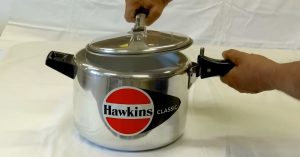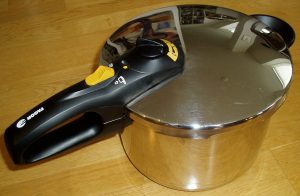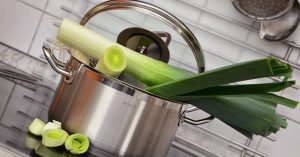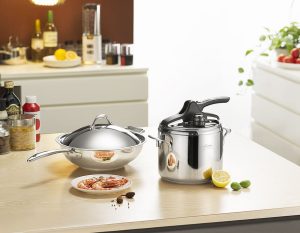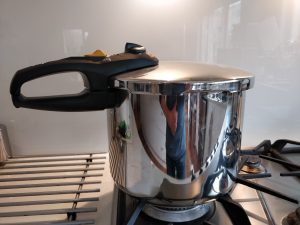My pressure cooker has become an invaluable tool in my kitchen, providing me with the means to cook my meals in an entirely sealed atmosphere. This ingenious appliance operates by increasing the temperature within its chamber through the boiling of liquids.
This process triggers a phenomenon of swift steaming or elevation. To initiate the pressure cooking magic, I usually utilize about 2 cups of liquids, often favoring something like a rich chicken broth for its additional flavor contribution.
Let me guide you through the myriad of advantages and disadvantages of pressure cooking that come into play when one chooses to adopt this method of cooking.
Advantages and Disadvantages of Pressure Cooking: Pressure cooking, while fast and efficient, comes with pros and cons. It saves time and retains nutrients, yet requires a learning curve and may alter traditional recipes.
Quick Navigation
Could you explain what a pressure cooker is?
A pressure cooker is like a big pot that you can seal tightly. You can find ones that go on your stovetop or ones that are electric and sit on your countertop. Their prices can be as low as $40 or as high as $300, depending on what kind and size you get.
When you use a pressure cooker, you cook your food in some liquid, like broth or water. Because the pot is sealed and keeps all the moisture in, the food cooks faster and ends up tasting like it’s been cooking for a long time. You can often cook food about two-thirds faster than usual!
The pot usually cooks at a high heat of 242°. Because it’s sealed, the steam can’t escape and just goes into the food. There’s also a valve that keeps track of the steam pressure and lets it out if needed, and often a gauge so you can see the pressure level.
This kind of cooking is great for making tough foods like roasts really juicy and tender quickly. It can be a lifesaver if you come home late and need to make dinner fast.
Just pop some chicken breasts or tenders, some carrot and potato chunks, and some broth or sauce into the pot, and you’ll have a yummy dinner in about 8-10 minutes.
Comparing Stovetops and Electric Pressure Cookers
Stovetop pressure cookers are usually better at browning food and can cook faster than electric ones. But they can be a bit loud when they let out steam while cooking. It can also be a bit tricky for cooking some foods, like rice.
Electric pressure cookers, on the other hand, are usually easier to use and don’t need as much attention while they’re cooking. They’re also pretty quiet during the cooking process. They only make noise when they let out the pressure after the cooking is done.
However, when the pressure is released, food can splatter onto the lid. Because you can’t take off the lid or wash it in the sink or dishwasher, it can be a bit hard to clean up.
Both types of cookers have their good and bad sides. But if you want to be able to just start the cooker and leave it alone, and if you like cooking rice, an electric pressure cooker might be your best choice.
Are you wondering if the noises your pressure cooker makes are normal? I recently wrote an article where I explained what noises are normal for an Instant Pot or pressure cooker.
It’s okay for a pressure cooker to make some noise or let out some steam and pressure. But it’s important to know the difference between normal and abnormal sounds!
What Distinguishes a Pressure Cooker from an Instant Pot?
Instant Pot is a popular brand of electric pressure cooker that people love right now. Like other pressure cookers, it can brown and sauté food, steam things, and of course, pressure cook.
Both Instant Pots and other electric pressure cookers are easy to use and clean and have more options than the stovetop kind.
Some things that make Instant Pots even better are:
- They have a stainless steel pot for cooking, not a non-stick one.
- They can also work like a slow cooker, just like a Crock-Pot.
- You can set a timer to start and stop cooking whenever you want.
For some people, it’s a plus that Instant Pots don’t have a non-stick surface, so nothing flakes off into your food. Also, because it can also work as a slow cooker, you can save some kitchen space by not needing a separate Crock-Pot.
Which Foods Are Most Suitable for Cooking in a Pressure Cooker?
Pressure cookers are great for cooking many types of meat. Basically, if you can steam or braise food, you can cook it in a pressure cooker. This includes:
- Soups
- Hard vegetables
- Beef (even the ground kind)
- Beans (especially when you’re using dried ones)
- Big pieces of meat, like roasts
- Chicken
- Potatoes
- Rice
You can even make some desserts, like cheesecake, in your pressure cooker. Sometimes, they even come out better than when you bake them in an oven.
Is Pressure Cooking Considered Detrimental to One’s Health?
No, pressure cooking does not result in the destruction of nutrients. Cooking food for shorter periods helps retain more nutrients. Therefore, pressure cooking is a healthier option compared to other cooking methods, as it preserves the nutritional value of the food.
By using a pressure cooker, you can maintain a higher nutrient content in your meals, making it a beneficial cooking technique for those seeking to optimize their health and well-being.
Is it True that pressure cooking Eliminates Nutrients from the food?
Some people worry that pressure cookers might destroy the nutrients in food because they use boiling. But actually, pressure cookers use a small amount of water that quickly turns into steam because of the heat and pressure.
Also, because the cooking time is shorter, pressure cooking keeps more nutrients than regular boiling on a stovetop.
The National Institutes of Health did a study comparing different cooking methods and how they affect nutrient loss. They found that steaming, which is how pressure cookers work, was the best at keeping nutrients in the food.
In their study, stir-frying made food lose 18% of its nutrients, microwaving made it lose 16%, boiling made it lose 27%, but steaming made it lose almost no nutrients.
So, pressure cooking is a really good way to cook your food if you want to keep as many nutrients as possible.
Is it possible for Pressure Cookers to Explode?
Pressure cookers have been around for as long as Crock-Pots have. Back in the day, people were really worried about pressure cookers building up too much pressure and becoming dangerous.
They would make a hissing sound and seem like a time bomb ready to explode if the pressure valve got blocked or if you cooked for too long. Sometimes, Grandma’s tasty stew would end up on the ceiling if she didn’t put the lid on right.
But today’s pressure cookers are really safe. They’re easy to use and have better ways to check the pressure to prevent any problems.
One thing to note is that you can’t just lift the lid to check your food while it’s cooking in a pressure cooker. In fact, one of the main downsides is that you can’t check on your food or adjust the taste while it’s cooking.
Because of the high pressure, you have to wait until the cooking is done and the pressure is gone before you can open the lid.
But there’s a lot more to know about whether pressure cookers can explode, like what could actually cause that to happen. So, be sure to read up on pressure cooker safety to learn more.
Is Botulism Eliminated through Pressure Cooking?
Botulism is a kind of bacterial infection that can sometimes be deadly, even though it’s pretty rare. Early signs can include feeling weak, having blurred vision, being tired, and having trouble talking. Then, you might start throwing up or have diarrhea.
The bacteria that cause botulism live in soil and water. Most of the time, people get botulism from food that isn’t cooked or handled properly.
The good news is that the botulism toxin can be killed by cooking food at 185° for at least 5 minutes. So, even though you should always clean your hands, kitchen, equipment, and food, pressure cooking can kill botulism as long as you cook your food for more than 5 minutes.
Advantages and Disadvantages of Pressure Cooking
Here are the advantages and disadvantages of pressure cooking:
Advantages of Pressure Cooking:
Here we discuss the advantages of pressure cooking:
Safety Features:
Undoubtedly, pressure cooker technology has advanced significantly over the years. Previous models were noisy and had the potential to be hazardous if mishandled, leading to lid blow-offs due to excessive steam pressure.
However, modern pressure cookers are designed with various safety features to prevent such incidents. These enhanced safety measures ensure that pressure cookers are now much safer to use.
With improved construction and mechanisms, today’s pressure cookers offer a secure and reliable cooking experience, providing peace of mind to users.
Preservation of Flavors:
Flavor is an essential element in cooking, and pressure cooking excels at preserving and intensifying flavors that can otherwise diminish during traditional cooking techniques.
The sealed and pressurized environment of a pressure cooker helps retain the natural essence and aromas of the ingredients, resulting in exceptionally tasty and delicious meals.
By locking in the flavors, pressure cooking ensures that each bite is infused with a heightened taste experience. Whether it’s tender meats, rich stews, or vibrant soups, pressure-cooked dishes are renowned for their robust and tantalizing flavors that can elevate any culinary creation.
Simplified Meal Preparation:
I really enjoy the convenience of being able to put all my ingredients in one pot, start cooking, and voila, in just a few minutes, my meal is ready.
I use my pressure cooker for making dishes like stews, beans, soups, curries, stocks, lentils, mashed potatoes, chicken, and any recipes that involve tougher cuts of meat. It’s a great time-saver and makes cooking simpler and more efficient.
The durability of the Stovetop Cooker:
Investing in a good pressure cooker is a wise decision. A well-built pressure cooker that is properly maintained can last for many years. The only component that might require replacement over time is the rubber sealing ring, but overall, these pots are incredibly durable, and almost impossible to damage, based on my experience.
Energy Efficiency:
Pressure cookers are incredibly efficient in harnessing heat compared to conventional pans, leading to significant energy savings. This efficiency not only translates to lower energy bills, providing long-term cost savings but also contributes to a more eco-friendly cooking experience.
By utilizing heat more effectively, pressure cookers reduce energy consumption and minimize waste. This makes them an environmentally conscious choice for those seeking to reduce their carbon footprint.
Embracing the use of pressure cookers not only benefits your wallet but also promotes sustainable practices by conserving energy resources and reducing environmental impact.
Minimal Mess:
Using a pressure cooker means less cleaning and fewer dishes to wash compared to regular cooking. With regular cooking, you often use multiple pots and utensils, but with a pressure cooker, you only need one pan. Additionally, the secure lid reduces the chances of spills and messes, making cleanup easier.
Retention of Nutrients:
Pressure cooking is known for its ability to retain a higher amount of nutrients and vitamins in food compared to traditional cooking methods using regular pots and pans. The sealed and pressurized environment of a pressure cooker plays a vital role in this nutrient preservation.
As the pressure cooker traps steam and heat, it effectively seals in the goodness, minimizing nutrient loss during the cooking process. The shorter cooking time in a pressure cooker further contributes to preserving the nutritional content of the food.
By retaining more nutrients, pressure cooking enhances the overall healthiness of meals, ensuring that you can enjoy dishes packed with essential vitamins and minerals.
Time-Saving Cooking:
One of the key advantages of pressure cooking is its remarkable ability to reduce cooking times, often by around two-thirds. This efficiency stems from the pressure cooker’s adeptness in trapping and harnessing steam and energy, unlike traditional pots where energy dissipates.
It is important to mention that stovetop pressure cookers typically offer faster cooking times compared to electric ones. With their superior steam retention and heat distribution, stovetop models excel at expediting the cooking process, allowing for quicker meal preparation.
Whether you opt for a stovetop or an electric pressure cooker, both options provide significant time savings in the kitchen.
Versatility:
Versatility refers to the ability of a pressure cooker to handle a wide range of cooking tasks and accommodate various types of food. Pressure cookers are incredibly versatile kitchen appliances that can be used to prepare an array of dishes.
From cooking meats, such as chicken and beef, to preparing soups, stews, beans, grains, and even desserts, pressure cookers excel in their ability to handle diverse recipes.
Additionally, pressure cookers can often replace multiple kitchen appliances, saving valuable countertop space and simplifying meal preparation. The versatility of pressure cookers makes them a valuable tool for home cooks looking to expand their culinary repertoire.
Disadvantages of Pressure Cooking:
Here we discuss the disadvantages of pressure cooking:
Limited Access for Monitoring and Seasoning:
While I appreciate using my pressure cooker, it can be frustrating that I can’t simply open the lid to check on the progress of the meal. Cooking involves a bit of guesswork, and visually inspecting or tasting the food is often the best way to determine if it’s done.
Additionally, adding the right amount of herbs, spices, and seasoning becomes more challenging without the ability to adjust and taste as I go along.
Limited Applicability to Specific Dishes:
While pressure cookers are highly effective for preparing dishes like stews and soups, they may not be suitable for other types of meals that require high-temperature roasting or direct heat exposure.
It’s important to note that pressure cookers are not designed to replace traditional methods for searing or grilling ingredients like steak. The nature of pressure cooking, with its sealed and pressurized environment, is more suited for slow and moist cooking techniques.
So, while pressure cookers offer exceptional results for certain dishes, they have limitations when it comes to high-temperature cooking or achieving specific textures typically associated with roasting or grilling.
Challenges with Diverse Cooking Times:
A significant drawback of pressure cooking is that all ingredients need to be cooked for the same amount of time. As a result, it becomes challenging to cook different elements of a meal together in one pot. This often requires the use of additional pots and pans alongside the pressure cooker.
Learning Curve in Operating Pressure Cookers:
While it may take some time to learn, using a pressure cooker shouldn’t deter you from getting one. It’s a unique cooking process compared to using a regular pot, but it’s not overly difficult, and most people quickly grasp the technique.
Concerns of Overcooking:
It’s quite common to accidentally overcook food, especially when you’re still learning to use a pressure cooker since the cooking times are much shorter. I made the mistake of overcooking my food when I first started, and just a few extra minutes can make a big difference.
It’s also important to be mindful of the ingredients you’re using, as some may cook well while others become overdone. I suggest using a beginner’s pressure cooker recipe book, at least until you become more familiar with the cooking times.
Learning Curve:
Learning Curve refers to the time and effort required to become proficient in using a pressure cooker effectively. While pressure cookers are convenient and offer various benefits, they can initially pose a challenge for new users due to their unique cooking methods.
Understanding the correct cooking times, and pressure release techniques, and adjusting recipes can take some practice and experimentation. However, with patience and experience, individuals can overcome the learning curve and master the art of pressure cooking.
Resources such as recipe books, online tutorials, and cooking forums can be helpful in navigating the learning process and enhancing one’s skills with a pressure cooker.
Size and Storage:
Size and Storage refer to the dimensions and storage requirements of a pressure cooker. The size of a pressure cooker can vary, with different capacities available to suit various cooking needs.
It is important to consider the available space in your kitchen and the amount of food you typically cook when choosing the appropriate size. Additionally, storage can be a factor to consider, as pressure cookers can be bulky and may require dedicated storage space in your kitchen cabinets or pantry.
Proper storage and organization of the pressure cooker when not in use can help maximize kitchen space and ensure easy access when needed.
Limited Monitoring and Adjustments
Here we discuss the limited monitoring and adjustments of pressure cooking:
Addressing the Inability to Open the Pressure Cooker During Cooking
When using a pressure cooker, it is crucial to understand that once the cooking process begins, it is not possible to open the cooker and check the food’s progress. This is due to the sealed and pressurized environment required for pressure cooking.
Opening the cooker prematurely can disrupt the cooking process, release pressure abruptly, and potentially cause accidents. It is important to trust the recommended cooking times and follow recipes closely to ensure optimal results.
Challenges in Monitoring and Adjusting Seasoning or Checking Food Progress
One of the limitations of pressure cooking is the difficulty in monitoring and adjusting seasoning during the cooking process. Since the cooker remains closed, it becomes challenging to taste the food or make seasoning adjustments.
To overcome this challenge, it is recommended to adjust the seasoning before the cooking begins based on the recipe’s guidelines. Additionally, it is essential to carefully follow recipes and measurements to ensure well-seasoned dishes.
While the inability to check food progress during cooking can be limiting, proper recipe selection and adherence can help achieve desired flavors.
FAQs:
Q:1 Is pressure cooking faster than other cooking methods?
Yes, pressure cooking is generally faster than traditional cooking methods due to the sealed and pressurized environment, which allows for quicker cooking times.
Q:2 Does pressure cooking retain nutrients in the food?
Yes, pressure cooking retains more nutrients in the food compared to other cooking methods, thanks to the shorter cooking time and limited exposure to air and water.
Q:3 Can I cook a variety of dishes in a pressure cooker?
Absolutely! Pressure cookers are versatile and can be used to cook a wide range of dishes, including stews, soups, meats, grains, vegetables, and even desserts.
Q:4 Is pressure cooking safe?
Yes, modern pressure cookers come with safety features, such as pressure release valves and locking mechanisms, to ensure safe operation. However, it is important to follow the manufacturer’s instructions and guidelines for proper usage.
Q:5 Are there any downsides to pressure cooking?
One potential downside is the learning curve associated with pressure cooking, as it requires understanding cooking times, pressure release methods, and recipe adjustments. Additionally, certain dishes that require high-temperature roasting may not be suitable for pressure cooking.
Q:6 Does pressure cooking require constant monitoring?
No, once the pressure cooker is properly set and the cooking process has begun, it requires minimal monitoring. However, it is essential to follow recommended cooking times and safety precautions.
Q:7 Can I open the pressure cooker to check the food while it’s cooking?
No, it is not recommended to open the pressure cooker while it’s cooking. The pressure and steam build-up inside the cooker must be released properly before opening the lid to avoid accidents. It’s best to rely on recommended cooking times and follow recipes for desired results.
Conclusion:
In conclusion, pressure cooking offers numerous advantages that make it a popular choice for many home cooks. It significantly reduces cooking time, making it a time-efficient option. Pressure cooking helps retain more nutrients in the food, resulting in healthier meals.
It also conserves flavors, resulting in delicious and flavorful dishes. The versatility of pressure cookers allows for a wide range of recipes to be prepared, from stews and soups to beans, grains, and even desserts.
However, pressure cooking also has its disadvantages. There is a learning curve associated with understanding cooking times, pressure release methods, and recipe adjustments.
Certain dishes that require high-temperature roasting may not be suitable for pressure cooking. Additionally, the inability to open the pressure cooker during cooking for monitoring or seasoning can be limiting.
Overall, despite the challenges, the advantages of pressure cooking outweigh the disadvantages for many individuals.
With proper knowledge, practice, and safety precautions, pressure cooking can be a valuable addition to any kitchen, providing convenience, time savings, and flavorful meals.
After reading this comprehensive article, we hope you will be well aware of the advantages and disadvantages of pressure cooking. If you have any questions, feel free to comment below!

